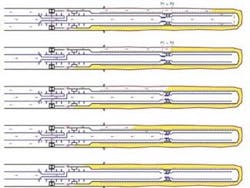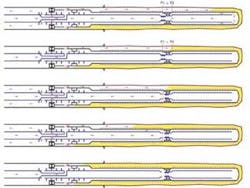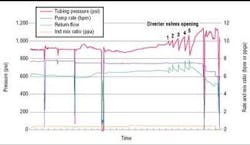Completing extended-reach, open-hole, horizontal well
By Martin P. Coronado & T. Gary Corbett, Baker Oil Tools
A new world record was set when Texaco completed an extended-reach, open-hole, horizontal well with a 6,943-ft gravel packed lateral section. The well, located in the Captain Field approxi-mately 90 miles northeast of Aberdeen in 369 ft water depth, produces heavy oil from a highly unconsolidated sandstone formation. Baker Oil Tools completed it with a new gravel packing technique. The technique uses special diverter valves strategically incorporated into the washpipe to maintain a pump rate that is high enough to reduce the potential for gravel settling in the workstring yet low enough not to exceed formation fracture pressure. The diverter valve concept was developed as an alternate method of addressing Beta-wave (return gravel wave) placement pressure, which is considered to be the primary limiting factor in gravel packing extended lateral completions. The new method essentially eliminates the Beta-wave pressure as a limiting factor and makes possible extended gravel packs that would not have been feasible using conventional methods, such as reducing the pump rate.
Two-stage process
The primary goal of open-hole gravel packing is to completely fill the annulus between the screen and the formation with high-permeability gravel pack sand. Although both low- and high-viscosity carrier fluids are used for gravel packing, low-viscosity fluid or brine is most effective in achieving void-free gravel packs under all well deviation conditions. The pressure control concept discussed in this article is applicable only when using low-viscosity carrier fluids.
Numerous studies using physical gravel pack models show that the gravel deposition pattern in high-angle (> 60°) wells is a two-stage process. In the first stage, the gravel pack sand slurry is pumped down the workstring and enters the large flow area in the annulus below the packer. With the increase in flow area, the slurry velocity decreases and gravel begins to settle on the low side of the wellbore. The settling gravel begins to form a dune that grows in height. As it does so, the available flow area decreases and slurry velocity increases. An equilibrium condition quickly develops where the slurry velocity above the dune is sufficient to erode the top of the dune and prevent further height growth. At this point, the dune begins to propagate down the length of the well in what is commonly referred to as the Alpha-wave.
The Alpha-wave continues to propagate down the well until it reaches the end of the screen or the end of the washpipe (whichever comes first), where the carrier fluid enters the screen and is circulated out of the well. At this point, the second (Beta-wave) stage of the high-angle gravel deposition process begins. During this stage, the gravel pack sand fills the annular area remaining above the gravel deposited during the Alpha-wave. The Beta-wave propagates from the toe of the well up to the heel. As gravel fills the annular area outside the screen, the carrier fluid is diverted into the restricted area of the screen/washpipe annulus to be circulated out of the well. As the Beta-wave continues to move toward the heel of the well, the distance of flow in the screen/washpipe annulus gradually increases, resulting in a steady increase in the surface pumping pressure. When the top section of screen is covered with gravel, a sharp increase in pump pressure occurs, indicating that the gravel placement is complete.
Hydraulic optimization
It is essential that the pump rate used to perform horizontal, open-hole gravel packs be sufficient to propagate the Alpha and Beta waves for the given downhole geometry and well conditions without fracturing the formation. Fracturing the formation during the gravel pack causes excessive fluid loss that could result in loss of control of the gravel pack and incomplete gravel placement.
Whereas the Alpha wave typically can be propagated the length of the horizontal interval at a high pump rate without exceeding the formation fracture pressure, the Beta-wave pump pressure in extended-reach, horizontal gravel packs will often exceed the formation fracture pressure if this pump rate is maintained. The conventional approach to controlling pressure during the Beta-wave is to reduce pump rate. While this method is valid, it has some disadvantages. The first is the additional time required to complete the gravel pack. Every reduction in pump rate reduces the rate at which gravel is added to the well; thus, the time required to complete the gravel pack increases. A second disadvantage is the possibility of gravel settling in the workstring. With low viscosity carrier fluids, sufficient velocity is required to prevent gravity settling in the workstring. In 3 1/2-in. drill pipe with 2.764-in. inside diameter (ID), a minimum pump rate of 1.5-2 bpm is generally required to prevent gravel settling. In 5 1/2-in. (4.778-in. ID) drill pipe, the minimum pump rate to prevent gravel settling increases to 7-7.6 bpm.
Diverter valve concept
The BetaBreaker diverter valve concept was developed as an alternative to reducing pump pressure during the Beta-wave phase of the gravel deposition process. The valve automatically operates to re-direct return fluid flow into the washpipe during placement of the Beta-wave. When the valve opens, return flow enters the washpipe through the valve, as opposed to the end of the washpipe. The net effect is a reduction in the length of screen/washpipe annulus in the flow path that reduces friction pressure losses and subsequently lowers surface pump pressure. Strategic placement of the valve(s) in the washpipe string (made possible with the aid of computational models) allows the Beta-wave to be propagated below the formation fracture pressure at higher pump rates to reduce gravel pack pump time and prevent gravel settling in the workstring.
The original concept for the diverter valve was influenced by the desire to create a gravel-free area around open-hole packers when performing open-hole gravel packs in horizontal wells. With the annulus around these packers void of gravel pack sand, the packers could be expanded against the formation wall, thus creating the best conditions for forming a pressure seal. A method to best accomplish a "void" in the gravel pack around an open-hole packer had to be addressed in two parts, regarding both the Alpha- and Beta-wave phases of the gravel deposition process.
During the Alpha-wave
To prevent gravel pack sand deposition around an open-hole packer during the Alpha-wave, the packer is sized with an appropriate outside diameter (OD) relative to the hole ID to achieve a flow area that causes the slurry velocity outside the packer to be at or above the critical transport velocity (300 ft/min using a low viscosity carrier fluid) when pumping at a chosen gravel pack pump rate. If the critical transport velocity is attained, the Alpha-wave dune height is effectively reduced to zero and no gravel pack sand settles in the annulus outside of the packer. The Alpha-wave propagates normally around the screen above and below the open-hole packer, but essentially "jumps" over the packer to leave the void required for future packer expansion. Using this method to create a void in the Alpha-wave does not restrict the number of open-hole packers in the well and is sensitive only to having a sufficient packer OD to create critical transport velocity.
During the Beta-wave
To prevent gravel pack sand deposition around the packer during the Beta-wave, a more complex solution was required. The Beta-wave had to be temporarily stalled when it reached the bottom of the open-hole packer and then continued above the packer. A technique was developed that required altering the return flow path of the carrier fluid once the Beta-wave reached the packer. Altering the return fluid flow path from the end of the washpipe to a diverter valve immediately above the open-hole packer causes the Beta-wave to be discontinuous, and thus not cover the packer.
Diverter valve design
The diverter valve was designed to be integral to the washpipe string and uses bonded seals similar to those used on the gravel pack crossover tool to seal off inside an open-hole packer or polish bore receptacle (PBR) incorporated into the screen liner. The bore through the valve is maximized to limit the amount of backpressure created in the carrier fluid return flow path. After the valve is sealed off inside the packer or PBR, an internal, spring-loaded piston senses differential pressure in the screen/washpipe annulus above and below the valve. Once a sufficient differential pressure is created (in favor of the upper annulus) to overcome the spring force against the piston, the piston moves down to uncover locking dogs. The locking dogs move radially outward to allow a power spring to drive the seal sleeve downward to expose flow ports.
After the valve is tripped open, the power spring maintains the seal sleeve in the retracted position and prevents the valve from being closed again. The flow ports establish a new entry point into the washpipe for the carrier fluid returns. Carrier fluid returns from the next higher screen section then enter the washpipe through the valve, thus shortening the fluid travel distance and reducing friction pressure.
Multiple diverter valves
Running several open-hole packers or achieving maximum Beta-wave pressure reduction requires multiple diverter valves. Sequence valve openings were a major design consideration. Having the valve sense the screen/washpipe annular differential pressure across the valve eliminated the sequencing problem since only the lowermost valve would be subjected to a differential pressure when the temporary screen-out occurred as the Beta-wave covered the screens just below the valve. Any valves positioned higher up in the washpipe string would not have a differential pressure applied since the screens are still open, i.e., not completely packed, both above and below the valve. The screen-out pressure would be applied to both annular sides of the valves, thus the internal triggering piston would not be affected. A differential pressure can only be applied across the valve if the screen section immediately below the valve position is covered with gravel pack sand. The gravel pack sand inhibits transmission of pressure through the screen and to the lower side of the diverter valve. This feature simplifies operation significantly. The surface operations being conducted during the gravel packing are unchanged when using the diverter valve(s).
Another benefit of using diverter valves in the gravel pack operation is the ability to monitor the progress of the Beta-wave as it moves toward the heel of the well. Pump pressure reductions as each successive valve is opened are clearly seen at surface, providing a tell-tale indication of Beta-wave location.
Field applications
To date, nine extended-reach, open-hole, horizontal gravel packs, including the world record well, have been successfully completed in the North Sea using the diverter valve concept described in this article for Beta-wave pressure reduction. All the wells have been completed in an 8 1/2-in. open hole below 9 5/8-in. casing using 5 1/2-in. screens and 4-in. flush joint washpipe. PBRs with 4.400 in. ID have been spaced out as required along the screen liner length. The diverter valves have been spaced out in the washpipe string to seal in the PBRs when the gravel pack crossover tool was positioned for gravel packing. Two to five diverter valves have been used per well. A total of 29 diverter valves have been run in these wells.
In addition, three wells have been completed in Brazil using the diverter valve concept to incorporate open-hole packers into the horizontal gravel packed hole section. These wells have been completed in an 8 1/2-in. open hole below 9 5/8-in. casing using 5 1/2-in. screens and 4-in. flush joint washpipe. Two open-hole packers have been run in tandem as part of the screen liner. A single diverter valve per well has been spaced out in the washpipe string to seal in the polished ID of the uppermost open-hole packer. After successfully gravel packing the wells and removing the gravel pack service tools, an inflation tool has been run to inflate the open-hole packers. Based on fluid volumes displaced into the open-hole packers during inflation, all indications are they have sealed directly against the 8 1/2-in. open hole indicating the desired void in the gravel pack around the packers has been achieved.



